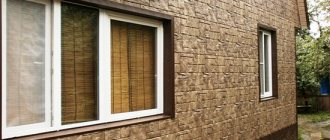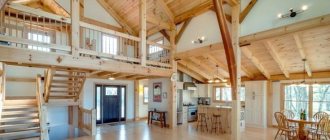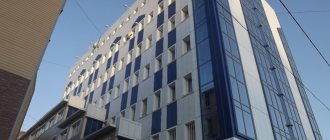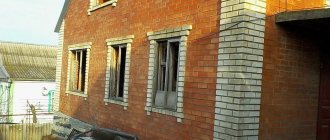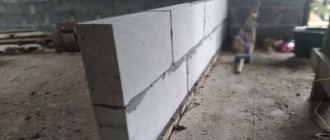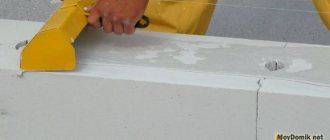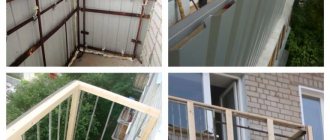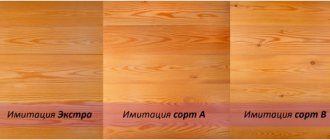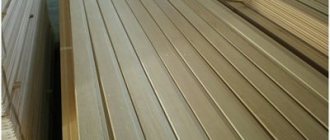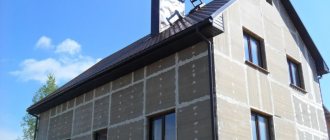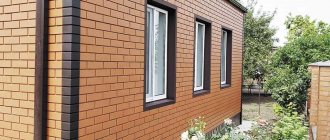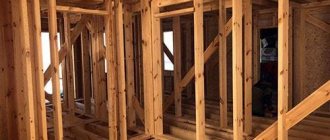A building made of aerated concrete can stand without external finishing without any damage to the integrity of the blocks (we are talking about autoclaved aerated silicate). But, over time, dust settles on the surface of the blocks, and the previously white outer surface becomes an untidy gray color with streaks. So it doesn’t matter, sooner or later, but the question arises about the cladding or finishing of aerated concrete on the outside. Inside, the finishing of aerated concrete is done almost immediately after construction: the blocks do not look very attractive in the interior.
This is what aerated concrete looks like without finishing after a few years
Since aerated concrete has very high vapor permeability, there are certain nuances when carrying out finishing work. The fact is that almost all materials conduct vapors worse than gas silicate. This causes difficulties, since in order to ensure normal removal of water vapor from the room, the vapor permeability of the walls - from the room - to the outside must increase. Only special plaster mixtures for foam concrete meet this requirement. But subject to certain rules, the finishing can be anything.
Why do you need to finish a gas block façade?
Aerated concrete is an artificial stone that belongs to the class of cellular concrete. It is created by mixing components such as cement, sand, lime, gypsum, and aluminum powder. The latter, when interacting with water, releases gas, which leads to the formation of bubbles in the structure of aerated concrete, as a result of which it becomes porous, or, as they say in the construction world, cellular.
Among the advantages of aerated concrete, due, among other things, to its cellular structure, one can highlight high thermal insulation properties, fire resistance and low weight. Thanks to these characteristics, it perfectly retains heat inside the house, protects it from fire and is quite easy to install.
However, porous concrete also has its disadvantages . The main one is hygroscopicity or the tendency to absorb water vapor from the air. In humid climatic conditions (be it rain, snow or fog), aerated concrete accumulates a large amount of moisture, which can lead to the appearance of fungus or mold, and a sharp drop in temperature can lead to cracks in the blocks and their subsequent destruction. Therefore, external finishing of aerated concrete walls with a material with good waterproofing properties is mandatory.
Fastenings to aerated concrete walls
With wet technologies everything is clear; they require special adhesive compositions. But it is necessary to warn that aerated concrete is not as durable a material as concrete or brick. Therefore, to install ventilated facades, it is necessary to use special dowels as fasteners, which are specially made for cellular concrete.
They are made of plastic (PE, PP or nylon) or metal (galvanized or stainless steel). According to the installation method, dowels are divided into driven and screwed. The latter are considered more reliable and are divided into straight and conical. A separate group are chemical anchors, which are liquid polymer compositions poured into prepared installation holes in aerated concrete, where they are polymerized.
What can and cannot be used in decoration
The high hygroscopicity of aerated concrete requires compliance with certain rules when choosing cladding and carrying out finishing work. The main thing is to remember that for normal removal of moisture from the room, the vapor permeability of the walls must increase from the inside of the room to the outside, that is, the facade material must allow vapor to pass through well.
This requirement is met only by special finishing mixtures for gas and foam concrete. However, with the use of a ventilated facade, other options can be used, for example, porcelain stoneware, siding or stone.
What should never be used in decoration?
- ordinary sand-concrete plasters,
- film-forming paints,
- thin slabs of foamed polymers.
Such finishing blocks the pores for water to escape, which means it will lead to its retention and, as a result, a decrease in the strength of the coating and its thermal insulation properties.
Which method to choose for external cladding, what criteria to rely on
Cladding a house from the outside is much easier, since the list of acceptable materials is increasing.
The facing material must meet GOST; certain requirements apply to it. Since the wall is always outdoors, it is exposed to the elements. Precipitation will constantly fall on the material, and do not forget about UV radiation. Soft material quickly becomes unusable. Heavy workpieces are also not suitable.
Factors when choosing:
- durability;
- sound insulation;
- cost (per square meter);
- thermal insulation.
Ease of processing is also important. When work is done on a wall where there are ventilation holes, windows, doors, you often have to trim the workpiece. It’s good if this can be done without damaging property.
How to choose the right material?
When deciding which option is best for your aerated concrete home, there are a few key points to consider.
- Budget . You must assess your financial capabilities and determine the amount you are willing to spend on improving the façade of your home. At the same time, the main thing is not to forget about maintaining a balance between price and quality.
- Appearance . How important is home attractiveness to you? If choices are made based solely on aesthetics, functional properties may be overlooked or overshadowed. It is important not to forget about them, because the durability of the entire structure depends on the protective role of the façade finishing.
- Climate . Weather factors can have an extremely strong impact on the coating: lead to the formation of cracks, mold and even its destruction. Assess the temperature regime in your region: not only seasonal averages, but also maximum levels. It would be useful to add another 15-20% “reserve” to the latter, since climate change is presenting more and more surprises. In addition to temperature changes, it is important to take into account the amount of precipitation, humidity, windiness, and ultraviolet radiation.
It is also important to decide how you will install the cladding and whether you need external insulation. The best option would be to choose good quality vapor-permeable insulation and install a ventilated façade with a decorative coating to suit your taste and budget.
Let's consider specific materials, taking into account the indicated nuances.
- Coloring . The cheapest method, however, is not resistant to environmental factors. Whether it is heavy rains or intense sunlight, the brightness of the coating will decrease. It is also practically impossible to remove contaminants from a painted surface. All this makes it necessary to update it every few years.
- Plaster . It is important to choose those types that are suitable, first of all, for gas blocks, and secondly, for use in your climatic conditions (this information can be obtained from the markings on the packaging). Applying plaster requires certain skills, but if done correctly it will last 10-20 years. However, it requires periodic restoration.
- Brick . One of the most expensive options. It is difficult to install and creates a large load on the foundation, but if you follow the correct installation technique and high quality material, it will last until the house itself deforms.
- Ventilated facade . Provides good air circulation and moisture evaporation for aerated concrete walls. Will last more than 50 years, depending on the chosen decorative coating. It is easy to clean from dirt, and individual cladding elements can be replaced independently if damaged.
Buildings made of aerated concrete block: the whole truth about the material
First, let’s consider: how does aerated concrete differ from competitors with similar properties? To do this, let’s assume that our house has already been built and let’s try to look at it through the eyes of a practitioner who has independently gone through all the stages of construction.
It’s probably worth noting right away that the cost of building walls from this material will be very attractive, relative to, for example, brick, which cannot but please any homeowner. This is further supported by ease of use: the aerated block can be cut, sanded, and given the desired shape, without having any professional skills.
Moreover, non-autoclaved aerated concrete can be made independently.
If we consider the technical component, the advantages of a house built from aerated concrete blocks will be as follows:
- A low thermal conductivity coefficient will make the house warm;
- The ability of vapor permeation will provide a comfortable microclimate;
- Despite their low weight, aerated concrete blocks are strong enough to ensure a long service life;
- The gas block can withstand up to 35 cycles of freezing and thawing, and this does not take into account subsequent finishing, in which materials used for their intended purpose can extend their service life
- Good block geometry has a beneficial effect on construction time.
- An undoubted advantage is the non-flammability and environmental friendliness of the material.
Aerated block house
- All of the above advantages can be seen in advertising of goods from almost any manufacturer. And we will try to look at this impartially.
- Is the price really that low? Yes, indeed, if you do not take into account subsequent finishing, without which aerated concrete will darken over time and lose a lot of its positive properties. In this case, one compensates for the other.
- The ability to vapor permeability, frost resistance, thermal conductivity and other characteristics can retain their properties only in the case of technically correct finishing and using suitable materials.
- In order for aerated concrete to serve for a long time and its advantages not to turn into disadvantages, protective and decorative finishing should be approached with special responsibility.
How to decorate the facade of a house
Tips for finishing aerated concrete
How long can aerated concrete buildings be left unfinished?
First, let's consider the question of how long an aerated concrete house can last unfinished without losing its performance properties.
As we noted earlier, this type of concrete has a cellular structure, as a result of which it absorbs moisture well and also removes it well. Therefore, in the warm season, even in the presence of precipitation, it feels great - all the liquid from its surface simply evaporates.
Winter, on the contrary, can have a rather negative impact on aerated concrete. At temperatures above zero, the blocks become damp, and when it drops, the water that gets into the pores begins to solidify and leads to cracking and destruction of the material.
One winter season is unlikely to lead to a significant deterioration in the condition of the blocks, but you definitely shouldn’t delay the finishing work too much.
If you nevertheless decide to live in a gas-block house for several years without performing external finishing, the main thing is to take care of waterproofing the facade . One of the inexpensive and easy-to-implement methods is to treat the surface with a water-repellent impregnation - a water repellent. In addition to protecting against water penetration, it will also protect the front part of the building from the appearance of moss, efflorescence or mold.
Another simple option to ensure moisture protection is to apply 1-2 layers of primer followed by plastering.
When to install?
In the off-season, it is highly not recommended to install the cladding, since all accumulated moisture from the surface of the house does not evaporate, and the applied external coating will only reduce the vapor permeability of the walls. Therefore, the best choice for this would be the summer.
Regarding the completion of the construction of the building, it is considered optimal to begin external finishing work after six months. During this time, the bulk of the moisture from the gas blocks will disappear, and therefore, the likelihood of their shrinkage and the appearance of cracks will be minimized.
When using paint or plaster for façade coating, it is necessary to first carry out the interior finishing of the room, since some of its stages involve increased water evaporation. If you use ventilated facade technology, you can start with the outer cladding.
Important! If you are the first to carry out exterior finishing work, be sure to carry it out outside the heating season.
In conclusion , I would like to note that the exterior decoration of a house made of aerated concrete is an essential condition for its long service life, and in its absence, the material will lose most of its advantages over other options for building construction and will begin to collapse under the influence of external factors.
Plaster
The plaster layer can be created not only as the basis for a ventilated facade or clinker tiles. With proper selection of the mixture and competent execution of the work, it will become an attractive design solution in itself. It is recommended to use only specialized facade plasters. When working with acrylic compounds, you can count on long-term preservation of beneficial qualities, but you should be wary of open flame (the material can easily ignite).
Silicone plaster, which absorbs little water and is relatively inexpensive, demonstrates a wide variety of textures, but a meager range of colors. It should not be used where a significant amount of dust and dirt will fall on the walls. The gypsum composition dries quickly and is not subject to shrinkage, and only one layer is enough for decoration. But we have to take into account a low level of vapor permeability and accelerated wetting under the influence of precipitation. In addition, the surface of the plaster is often covered with stains, they will have to be painted over immediately - there is simply no other way to deal with it.
Combination options
When using a combined finishing method, it is necessary to take into account both the technical properties of the materials and the design features of the combination. The basic rules for using the combined method are:
- Use no more than 4 types in design.
- The use of heavy materials such as stone, brick in the design of the basement, and lighter materials such as plaster and tiles for the upper floors.
- Using one color scheme when selecting materials.
The combined method of decorating the facade of a house most often finds practical implementation in several basic standard forms:
- Brick, stone or tile is used for the plinth.
- Door and window openings are decorated with clinker tiles.
- The external and internal corners of the house are decorated with tiles or artificial stone.
- The main area of the walls is plastered and painted.
- The ground floor is decorated with wild stone, the rest of the wall surface is covered with clapboard or siding;
- Using thermal insulation material, an imitation of wooden beams is made on the surface of the walls.
- After applying the plaster, the main area is painted in light colors, and the protrusions are painted with brown paint.
